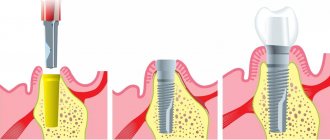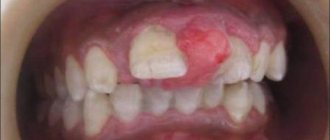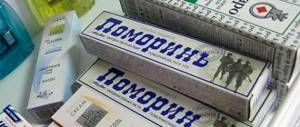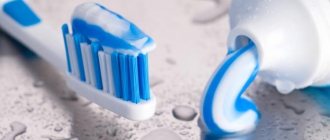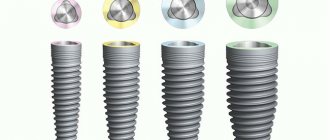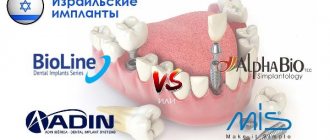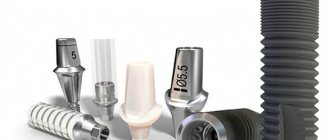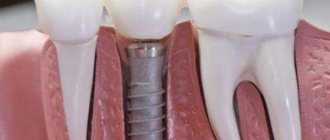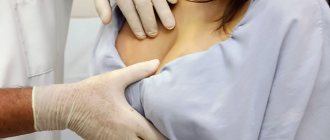An implant in dental practice is a multi-component structure that completely imitates the patient’s natural tooth in the jaw row. An artificial tooth is installed through bone integration; in a word, implants play the role of a lost root.
After implantation, the tooth itself is formed in shape, color, and composition. Modern developments in medicine and health make it possible to create the latest advanced designs that have high technical and quality characteristics without compromising durability.
High quality implants include Korean products OSSTEM.
Creation and high achievements in world practice
A dental working materials company was established in South Korea in early 1992.
Today, the company is only strengthening its international significance in its target international market. In Korea alone, the OSSTEM implant system accounts for up to 80% of the entire domestic market in the dental services segment.
The history of the development of OSSTEM Implant is continuously connected with the use of only the latest innovative developments in medical engineering, offering the most interesting and fresh solutions for professional implantology.
Already in 2006, a factory for the production of implants with the assigned Hiossen brand was founded in America. In the world ranking, OSSTEM Implant is among the top ten manufacturers. The products are premium products and are popular among patients and dentists in more than 60 countries around the world.
The principle of success lies in their impeccable quality and affordable price. The company's product catalog includes models at the most affordable prices, which are not inferior in quality and durability to their more expensive counterparts.
The Korean manufacturer OSSTEM often conducts seminars and master classes on implant installation for specialists and patients (at the company’s expense).
The company manufactures products installed in one or more stages, and temporary ones, which are necessary at the time of restoration of bone tissue after osseointegration.
Key indicators and advantages:
- reliability, safety;
- high quality at an affordable price;
- high wear resistance;
- minimal risk of rejection;
- it is permissible to install with low bone strength.
The surface of the products is treated with a special substance that forms a rough film. Therefore, the risks of rejection are quite low.
The design provides for minimal trauma to the jaw bone at the time of surgery, and the abutments are highly durable and reliable.
Implants have a high level of stability within the bone tissue, which allows installation in jawbone of varying densities.
It is important to know the basics of caring for removable dentures and some nuances to increase their service life. Click here to find out how to rinse a wound after tooth extraction.
Go to this address https://dr-zubov.ru/ortopediya/nesemnye-protezy/kakie-luchshe-vstavlyat-obzor.html to find out which is better to insert chewing teeth.
Average cost implants
Dental designs in the mid-price segment are inferior to premium ones in some respects. These are high-quality implants that take root well in the gums. Their use rarely causes complications. Prosthetics using them is cheaper. The cost of mid-price implants is 25-35 thousand rubles.
This category includes:
- Oraltronics
(Germany). German titanium implants with double FBR coating. They are characterized by fast and good survival rate and high primary stability. This allows you to speed up implantation, reducing the time between prosthetic stages. They have almost no contraindications; the bone settles minimally during implantation. - SuperLine
(South Korea, USA). The Dentium brand is from South Korea, and the system is developed at facilities in the USA. Installation of SuperLine implants is characterized by minimal trauma and rapid survival. Thanks to the special design of the double threaded rod, it is suitable for use in clinically difficult cases. Forms a single system with bone tissue. The model range includes both standard implants and products for one-stage implantation. - Anyridge
(South Korea). The systems of this brand are distinguished by simple and low-traumatic installation for the patient. With their help, you can carry out prosthetics even immediately after tooth extraction. They have practically no contraindications; they can be installed in dense and loose bone tissue, with a narrow bone or lack of height. The rod takes root quickly and is highly stable. The surface of the rod is coated with calcium ions, which accelerates healing. - ROOTT
(Switzerland). Implants for one-stage installation. They are used when two or more teeth are missing in the dentition. The procedure is performed under local anesthesia in one visit to the doctor. The rehabilitation period is about 3 weeks. The main advantage of this system is the absence of contraindications. It can be installed for any condition of bone tissue, for periodontal diseases. - Bicon
(USA). Bicon systems use a screwless connection. The abutment can be positioned 360 degrees. This makes the system one of the best in its segment. The procedure is minimally invasive. The rod takes root quickly and well, forming a single system with the bone tissue. - BioHorizons
(USA). Suitable for use in difficult cases - with loose bone tissue, in conditions of limited interdental space, etc. The shape, which follows the root of the tooth, facilitates installation and allows the use of implants even immediately after removal.
A little about materials and manufacturing technology
The main material is surgical titanium without additional alloys. Almost all modern manufacturers make their dental structures from it. This is due to the high strength of the material and the low level of reaction of the immune system to a foreign body.
Titanium is considered a hypoallergenic material, and only in 3% of cases were any allergic reactions triggered, which contributed to the development of implant rejection.
Titanium implants are widespread not only in dental practice for prosthetics, but also in surgery (orthopedics section). The products have a silvery gray tint, which is close to the natural color of the tooth root.
Production undergoes multi-stage control and numerous clinical studies to achieve incredible results. The threads in screw implants are precise, with a slight stop to prevent screwing in too deeply.
OSSTEM can be installed almost immediately after the gums have healed (after 6 weeks) or a little later, when the bone has completely recovered. The manufacturing technology is a high-precision combination of special techniques and devices and is aimed at achieving only excellent results.
Korean designs are intended for professional prosthetics using exclusively modern techniques in implantology.
Significant benefits
The products can eliminate both local defects in the jawbone and replace the entire dentition.
Often patients need to completely replace a removable structure with permanent teeth. With the help of modern computer modeling and advances in medical engineering, it is possible to make any patient’s smile complete.
In terms of their technical characteristics, the models are far ahead of their foreign counterparts. Key Features:
- variety of abutments;
- sandblasting the surface (creating a relief for better implantation into the bone);
- high biocompatibility with bone and soft tissue;
- fast survival rate;
- open thread due to the absence of the last turn at the base (reduces the load on the bone);
- special fine thread (provides initial stability);
- long-term warranty (subject to high-quality installation and proper oral care);
- hermetic connection of the abutment with the implant (prevents the penetration of food or pathogenic microflora into the prosthesis cavity).
For each model, a special sterilized packaging is produced, the integrity of which is broken only before prosthetics. This measure allows you to reduce the risk of inflammatory processes at the initial stage and prevent the installation of a fake.
The products are marked, which allows you to accurately select the required implant. South Korean manufacturers regularly conduct special seminars on the correct installation of OSSTEM implants, reducing the risk of rejection, and share new developments and medical techniques with colleagues.
Catalog and samples
The official catalog lists all models for one-stage or two-stage dental implant installation. All products are divided into 4 active installation systems: TS, SS, US, MS. Each system has its own characteristics and differences. It is worth considering each system separately in more detail.
TS design
The newest system from the entire OSSTEM line. It is characterized by the presence of a surface with special processing methods (use of CMP technology). This allows the implant to integrate into the jawbone much faster.
The rate of osseointegration is almost 25% higher than when using prostheses with an RMB surface. The structure of the metal rod is 95% similar to that of human bone tissue, so natural bone cells penetrate much deeper into the structure and provide a particularly strong connection.
The system is of the submersible type (threaded). The products are fastened from the inside to the abutment with a hex key. The length is 6 - 13 mm depending on the type of model:
- Model TSII. Small thread stroke, diameter from 3.5 to 5 mm. It is a root shaped like a cylinder. Provides high stabilization of the structure and prevents loosening.
- Product TSIII SA. The diameter of the product is from 4 to 4.5 mm with a pronounced conical shape. Designed to replace the root system of a tooth on the upper jaw bone using minimal screwing.
- Model TSIII CA. Diameter parameters vary from 3.5 to 7 mm. It is a wide implant for installation in one stage with the possibility of further physical impact. The surface is additionally treated with a calcium solution in capsules.
- Type TSIV CA. The model is presented in the form of a small cone for quick installation in one step. It has a calcified coating and a suitable shape for stable fixation in low-density bone tissue.
In the video you will find all the details of installing the Osstem TS4 implant
SS-system for dental prosthetics
Features of the system include the presence of double threads and fastening to the abutment with a special hexagon from the inside.
The edge of the platform surface is slightly wider than the main rod, so the connection of the fabrics will be maximized.
The surface of the structure is treated with special materials for instant fixation in the jaw bone. All models of SS systems are indicated for replacing a lost unit of dentition . The official catalog contains the following models:
- Type SSII SA is intended for one-stage prosthetics with subsequent early loading of the jaw. Made in a straight body, which allows you to control the depth of immersion into the bone.
- SSIII SA. The model is made in a wedge-shaped body with installation using a hexagon screw. The width of the working platform above the rod is 1 mm or more. Provides high stability at the end of the operation.
- Type SSII UKR. The model perfectly distributes the load on the jaw bones, and the abutments are secured with a hex screw from the inside. The design completely eliminates the entry of foreign bodies and food debris into the rod.
- Product SSII RBM. The type is represented by the widest implants with a diameter of 6 or 7 mm. Used to replenish teeth with lost molars.
- Product SSIII RBM. It is made using a self-tapping fine thread type for more effective immersion and bone fixation. Provides quick fixation and is recommended for subsequent chewing loads. It is used to replace lost molars in the jaw bone of any density.
- View SSIII RBM. The type is shaped like a small cone with fine threads for better screwing into the jawbone. Suitable for immediate administration and subsequent chewing load.
If a piece of a molar breaks off, what should you do in this case? Read reviews about Splat Active toothpaste in this article.
Go to this address and learn about the types of conduction anesthesia in dentistry.
US designs
The US dental system is made in various variations, which allows you to solve almost any dental problem.
The main advantage is the possibility of installation in any part of the jawbone, regardless of its natural density.
The diametric parameters of all implants are 3.5 - 5 mm with a length of 6 - 13 mm. Each model is distinguished by its design advantages and features:
- Product USII SA. The model is made in a straight body with the ability to control the screw-in depth. Provides reliable fixation in porous areas of bone tissue.
- Variety USIII. It is made in the shape of a wedge, which reduces trauma to the jawbone and ensures instant “planting” of the artificial tooth root.
- View USII RBM. The main advantage is the fastening of the abutment thanks to the external hex system. The product itself is made in a double conical shape with fine carvings. These advantages allow the implant to fit securely into the bone tissue and prevent the possibility of loosening .
- Product USIII RBM. The system is equipped with a three-lobed wedge-shaped edge that allows self-penetration into the soft tissue and bones of the jaw .
- USII UKR. It has a pronounced width of the platform and base. Provides reliable replacement of the root part of the tooth.
Designs according to the MS system
MS system products are often indicated for fixation into narrow jaw bones. They have a small diameter, and the platform is attached to the abutment so that it is a monolithic structure without additional connections.
Constructions of this type are classified into the following types:
- To restore the dentition with one or more artificial structures in the lower jaw. The microthread and narrowness of the body ensure stable stability of the rod, preventing it from loosening. The average price without specialist work is 3,000 rubles.
- For one-stage installation of both a complete dentition and replacement of local areas with lost teeth (MS Provisional). The narrow base of the platform allows you to compensate for the entire screwing path. The average cost without work for 1 unit is 1,500 rubles.
- For quick installation with further chewing load (MS Denture). It is prescribed when it is necessary to restore the dentition of the upper and lower jaw bones. The average price for 1 unit without work is 2,500 rubles.
Abutments - concept and features
In prosthetics, an abutment is understood as an intermediate part between the dental implant itself and the crown of the tooth. In other words, the abutment is the periosteal part of the implant that holds the entire artificial structure.
Thanks to abutments, the tooth is securely fixed in its place in the dentition. Abutments can be in the form of a monolithic or complex structure with fastening, look like a dental bridge or a completely removable denture, and can also be a single crown for the loss of one tooth.
They also differ in the method of installation, for example, if during the operation it is necessary to achieve special parallelism and the use of corner adapters.
The OSSTEM company also produces medical instruments used for dental prosthetics, and several types of different abutments, for example:
- permanent straight abutments;
- permanent;
- corner with permanent fixation;
- temporary for precise formation of gum tissue;
- in the shape of a ball for beam fastening.
The cost of each abutment, depending on its purpose, varies from 1,500 to 7,000 rubles.
Osstem: an honest review of the TS-3 series implants
Doctor on duty for the section
|
08/05/2019
|
Reviews and tests
Osstem implants have been manufactured in South Korea since 1997. Until recently, they were sold mainly only in the countries of the Pacific region. In some countries, the same implants are sold under the Hiossen brand (at a higher price), which is the company’s marketing strategy.
There is a lot written in advertising brochures about the fact that these implants are the most affordable of the premium segment implants, only at a more affordable price. It is extremely difficult to find reviews on Osstem implants - due to their not very wide distribution both in our country and in Europe. This article will show you how objective advertising claims are.
Osstem implants: types and characteristics
Osstem implants come in 2 types: MS series and TS-3 series. The latter is a classic universal implant (for any type of bone), with three surface options. According to the manufacturer’s recommendation, they can only be used for the classical two-stage implantation technique, and (depending on the conditions) the start of prosthetics can be carried out in a period from 6-8 weeks to 3-6 months.
Therefore, if you need implants for immediate implantation (when prosthetics are performed immediately after surgery), Osstem TS-3 implants are definitely not suitable for you. The MS series, in turn, is designed for use only in narrow spaces, for example, with a narrow alveolar ridge.
Let us tell you more about the TS-3 series implants
TS-3 series implants are the company's main product. According to the manufacturer: they have high self-tapping ability and very good primary stability. Undoubtedly, these characteristics are very important.
Analysis of implant characteristics
There is absolutely nothing premium in this implant, that is, it is the most common implant with the characteristics of economy segment implants. This is also evidenced by its low purchase price for dental clinics. But how does it differ from its analogues?
Unique carving
The aggressive thread of the implant with a high ability to self-tapping threads in the bone bed of the implant allows the implantologist to slightly change its direction while screwing in the implant - this is often necessary. However, this also has disadvantages: it is very difficult to control the correct direction of screwing in the implant, which spontaneously tends towards lower bone density.
As a result, the implant will not be in the position that was intended. An attempt to unscrew and re-twist an implant with an aggressive thread always leads to the same result - the implant will not receive any primary stability, but will simply dangle in the bone bed.
In addition, aggressive threading occurs throughout the entire length of the implant. Its presence in the upper third of the implant will definitely lead to atrophy of the bone tissue around the neck of the implant - with a subsequent deterioration in aesthetics (the appearance of cyanosis of the gums and gum recession). That is why most manufacturers use microthreads in the neck area of implants, which do not transfer a large load to the marginal bone and therefore do not lead to significant bone atrophy.
High primary stability
The implant has a conical shape and a pronounced thread, which really gives it good primary stability. Primary stability refers to how reliably (firmly) the implant holds in the bone after screwing. However, despite this, the manufacturer does not recommend using these implants for immediate loading. Prosthetics on these implants is possible no earlier than after a period of 6-8 weeks to 3-6 months.
Three types of Osstem implant surfaces
In the company’s catalog, the TS-3 series of implants is presented in three options: implants can be supplied with “SA”, “CA” and “HA” surfaces. It should be noted that Osstem specifically named their surfaces differently from common international names to make their products look more unique. However, their “SA” surface is nothing more than the “SLA” surface; in other implants, the surface of the implant is not completely unique, since almost 95% of all implants in the world have just such a surface. In this case, SA surface means that the titanium surface has been sandblasted followed by acid etching.
In addition, the Osstem company is a little incorrect. In advertising materials, they use clinical studies in which they compare their SA implant surface - not with similar SLA surfaces of implants from other manufacturers, but with an obsolete surface such as RBM.
They say that cellular regeneration and engraftment of implants with an SA surface are 20% better than that of implants with an RBM surface. The difference between SA/SLA and RBM is that the first surface is produced by a combination of sandblasting and acid etching, while RBM is produced by sandblasting alone.
The "CA" surface of the implant is according to the company's statements, i.e. this surface will have increased wettability with blood, which also promotes accelerated deposition of fibrin threads between the surface of the implant and the bone, which somewhat stimulates osteogenesis.
It's a really nice surface, but it's not unique. All top manufacturers have long been using technologies to create implants with a negatively charged ultra-hydrophilic surface. This surface reduces the risk of poor implant survival in smokers.
The “HA” surface of implants is a very thin layer (less than 10 nm) of resorbable hydroxyapatite material that is applied to the SA surface of the implant. According to the company, this helps improve the primary stabilization of the implant in the bone bed immediately after surgery. However, materials from the company itself indicate that there are still more problems with this surface (the top layer may peel off, which, on the contrary, leads to a slowdown in primary osteogenesis).
Conclusions: it would seem that implants of this type should be recommended in the area of the anterior teeth, because The neck of the implant is completely immersed in the bone - should allow one to achieve good aesthetics in the area of the transition of the gum to the crown on the implant. And this is the most important and difficult task in implantology. However, aggressive carving in the area of the implant neck will contribute to bone atrophy - with the subsequent appearance of gum recession and cyanosis.
In addition, in our opinion, it is not worth using implants with such threads in denser bone types D1 and D2, because Aggressive carving promotes dense bone resorption. For dense bone types, cylindrical implants with a less aggressive type of thread are more suitable, for example, implants from AstraTech or Straumann.
So: Osstem TS-3 implants are inexpensive and of fairly high quality . With the correct choice of installation location and the doctor’s steady hand, they will serve for a very long time. Recommended for smokers to reduce poor survival rates.
Based on materials from the article by Kamenskikh K.V. — implant surgeon, 19 years of experience
Tags:
dentistry
|
drug review
Previous post
Next post
Evgeniy, Ekaterinburg
|
24.09.2019
In any case, Osstem implants are among the most inexpensive in Yekaterinburg
Administrator
|
24.09.2019
Evgeniy, we completely agree with you: one of the best ratios of price and quality
Olga, Ekaterinburg
|
01.10.2019
Almost convinced! Mom needs to get implants. How to sign up for a consultation?
Administrator
|
01.10.2019
Olga, you can sign up through the form on our website or by calling
Write a comment
